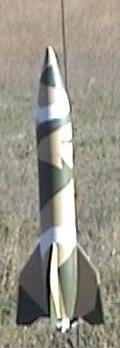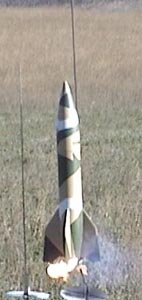Scratch Liddle V2 Original Design / Scratch Built
Scratch - Liddle V2 {Scratch}
Contributed by Sean R Liddle
| Manufacturer: | Scratch |
 Brief:
Brief:
Scratch designed and built V2 using LOC nosecones and Estes body tube.
Construction:
One Estes BT-80 body tube, four fins (1/8" plywood), plywood centering
ring (1), LOC MM2 motor mount kit, 1 inch elastic shock cord and 1/8 inch nylon
cord shock cord mount, small eyebolts for mounting cord, two LOC 2.56 nosecones
for nose and boattail.
After printing out patterns for fins from Rocksim (see Rocksim file link button above), fins were cut and sanded. Nosecone to be used for boattail was cut by removing tip until internal measurement was found to be slightly larger than outer diameter of 29mm motor mount tube. Base of cone was then cut leaving about 1.5 inches of shoulder remaining to couple boattail to BT-80 tubing. The removed portion was retained for construction of a piston.
The MMA2 motor mount adapter was constructed in such a way as to have the inner 29mm tube past the bottom centering ring of the outer tube by only 1 cm. This stepped area allows for injection of epoxy around the MM tube and resulting with a firmer connection between the MMA and the boattail at the base. Epoxy the large centering ring onto the upper end of the motor mount tube then the MMA assembly into the boattail. Then eyeball it center and allow it to dry. When dry, drill a small hole into the upper centering ring about 1 cm from the edge and epoxy in a small epoxy in the hole. Insert and epoxy the centering ring and the shoulder of the boattail into the BT-80 . Allow to dry overnight. Mark the slots onto the boattail then cut the tab holes. I used a very sharp Exacto blade after a bad experience with my Dremel Tool.
I then constructed a piston using the piece of the nosecone I cut off to make the boattail. I won't describe it here as I have discovered that the lack of space between it and the upper centering ring caused problems. It is a good idea for larger rockets. I am sure (feel free to try it), but I will be removing it from my personal V2. Epoxy the fins in place and allow to dry 2 hours. Insert 75-100 grams of plasticine into the second nosecone (the real one) pack it in place by use of a chopstick (my tool of choice) or other implement. Choose a chute, construct it as needed. I made one out of ripstop nylon, using hemming tape to seal the edges and small grommets to act as shroud line holes. Tie the nylon shock cord mount to the eyebolt by making a loop and shoving it through the eyelet with a pencil. Sure you could tie one on before you glued the boattail to the body tube, but that's not adventurous is it? Tie 1 meter of elastic from the nosecone to the shock cord mount. Tie other to the nosecone. Add the chute and you are good to go.
 Flight:
Flight:
As I mentioned, the piston was a BAAAAAD idea. First flight was an F25-4. Three
tries to ignite and when it did a small cloud of flame popped out of the engine
nozzle and crept up the fins, 1/2 a second later off she went, ZOOOOOOOM.. High
and straight! Then the ejection went. The nosecone, piston and parachute landed
500 meters downrange in a horse field. The body fell 100 meters plus for a safe
landing in a garden! Examination showed that even though I added two sheets of
Estes wadding to the motor mount tube ahead of the engine, the elastic still
burned enough to fail. Next launch in two weeks with no piston!!
Flew very well. Very very exciting flight! Will remove piston soon.
Next flight is an Aerotech E motor.
UPDATE:
Three weeks after the maiden flight on my V2, I have made a small modification, and subsequently two more flights.
Modification: Removal of piston, addition of 1/4" swivel between nylon shock cord mount and shock cord.
Flight one: 01/12/02. 10:40 am, Kingston, Ontario. Winds: 20km/hour, slightly overcast skies, 7 degrees Celsius. Engine: Aerotech E30-7T
Nice straight off the pad launch. Slight cocking into the wind. Ejection a few seconds after apogee. Fast decent 250 meters downwind from the pad. Slight damage to the fillets (most of which was simply damage not repaired from first flight). Nice flight and recovery.
Flight two: 01/12/02. 11:20 am, Kingston, Ontario. Winds: 20km/hour, slightly overcast skies, 7 degrees Celsius. Engine: Aerotech F50-9W
V2 flew off the pad with a roar. Okay, more of a loud whoosh. Cocked, as expected, into the wind about 15 degrees from the pad. Climbed approx. 2500 feet (according to Rocksim). Chute deployed a few seconds after apogee and rocket hung. And hung and hung. Then started to ever so slowly head downwind. It passed over the field, the line of trees, the swamp, a large open field and just before landing in the next largest field, found the top few branches of a 20 foot tall tree which was covered in thorns. The only tree in the area. Apparently there was an upper level wind we were unaware of. After a large degree of bloodshed, torn clothing and language best used in an R rated movie, the tree was climbed and the V2 was recovered intact.
I will save future flights for Aerotech E engines until the spring launches at the local vacant military airfield when it shall touch the clouds with a G.
Sponsored Ads
 |
 |











